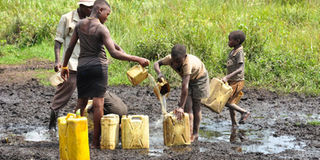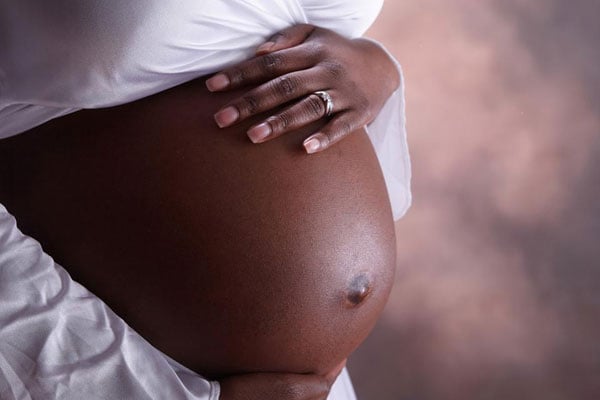Rubirizi needs Shs3b to get safe water for thousands

Children draw water from Kyabazo swamp in Rubirizi District last Monday. PHOTO/FELIX AINEBYOONA
What you need to know:
- The RDC, Ms Harriet Nakamya, says he instructed the CAO to write to the Ministry of Water and Environment to intervene since the district does not have the required funds.
Several households in the parishes of Ndangara and Rumuri in Ryeru and Kicwamba sub-counties respectively, do not have safe water, putting their lives at a risk of waterborne diseases such as typhoid, cholera and diarrhoea.
Their source of water is Kyabazo swamp in Kabukwiri Village, in Ndangara Parish. But the water is highly contaminated since the swamp is surrounded by several homes that dump there dirt and rubbish.
Ms Evelyn Nabahigwa, a resident, says the water source was further contaminated during the grading of Nyakiyanja-Kabukwiri-Rumuri road in 2019.
“The water turned brown because of soil deposits from the road,” Ms Nabahigwa says.
Mr Apollo Kakiga, the Kabukwiri Village chairperson, says on top of lack of clear water, the area does not have a government primary school.
“We do not have clean water and a school yet President Museveni, while canvassing for votes in 2016, said every parish would have a UPE school. Kabukwiri has many children and they all travel 8km to go to the nearest government school,” Mr Kakiga says.
Ryeru Sub-county chairperson Richard Guma Kimunyu said he has written to the chief administrative officer (CAO) and the resident district commissioner (RDC) about these community challenges.
“I have asked the CAO and the RDC as the representatives of the central government and the President to petition higher authorities to come to the rescue of our people,” Mr Kimunyu says.
The district vice chairperson, Mr John Mubangizi, says they are aware of the problem but to providing clean water to the area requires a lot of money which they do not have.
The district water officer, Mr Frank Nyerinde, says about Shs3 billion is required to pump water from the nearest reliable water source, Lake Kako, about 5km away, to the affected area.
Investment needed
“It requires establishing a booster station, pumping water to a reservoir, then pipes from that reservoir to supply the whole of this area. It would require using GI (galvanized iron) pipes not plastic pipes, which makes the project very expensive for local government to execute,” Mr Nyerinde explains.
He adds that the district receives Shs371 million for water
sector in a financial year.
“This swamp serves six cells; the district constructed two shallow wells in the area but they do not have enough.
water- when they fetch 10 jerry cans, it dries up. This is a rift valley whereby the soil underneath cannot hold water,” Mr Nyerinde says.
The RDC, Ms Harriet Nakamya, says he instructed the CAO to write to the Ministry of Water and Environment to intervene since the district does not have the required funds.
“We wanted these people here to get gravity flow scheme but the technical people at the district say it’s a big project and needs a lot of money. So I have instructed the district technical team to write to the Ministry of Water to help people in this area,” Ms Nakamya says. The safe water coverage in the district is at 68 per cent.
Water access
Statistics. According to statistics from the Ministry of Water and Environment, the country as of 2018 had 65 per cent access to safe water in rural areas and 77 per cent in urban areas. Although open and spring wells, boreholes, tanks and piped water taps are the main sources through which government has extended safe water throughout the country, rivers and lakes are still the source in some remote areas. The safety of water across all sources is, however, not guaranteed as it is compromised by structural factors during transit.




